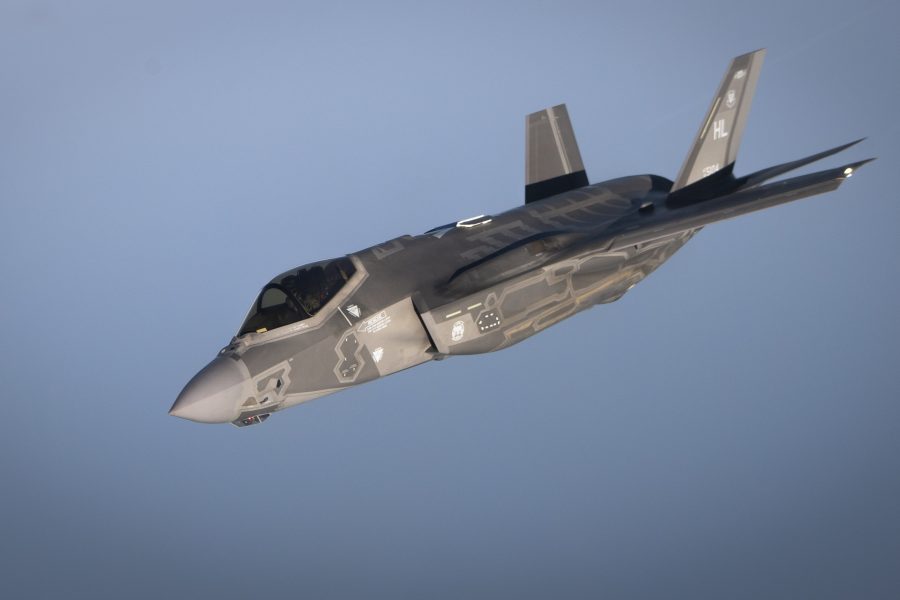Due to pandemic-related slowdowns, Lockheed Martin expects to deliver 122 F-35s in calendar year 2020—20 less than planned. To avoid surging and then slowing production on the line, which would increase cost, the delayed jets will be delivered over the next two years, company executive vice president for aeronautics Michele A. Evans said Sept. 9.
“It’s actually going to take us a couple of years to recover those 20 jets,” Evans said in an interview with Air Force Magazine. “What we don’t want to do is drive our capacity way up” to make up the shortage and then ramp down to a more efficient rate afterwards, she said, creating “spikes and low points.”
The company has an agreement with the F-35 Joint Program Office “that by 2023 we will have recovered whatever jets we don’t deliver this year, and it’s really helping them” by giving suppliers who may have been affected by the pandemic the ability to recover their production capacity more predictably.
“We’re really now at ramp rate on F-35, so we really want to stick at that rate, and we want our suppliers to optimize and drive cost efficiency,” she said. Leveling off at about 11 airplanes per month “makes sense in terms of capability and cost.”
Lockheed, which flowed significant funds to its supplier base to keep small enterprises in business, has developed an overall package addressing its COVID-related costs. It’s also working with the Pentagon to “arrive at a global settlement, … similar to what’s been done … in the past,” she said.
Pentagon acquisition and sustainment chief Ellen M. Lord expects it will take five or six months to collect COVID-related costs incurred by the defense industrial base and provide between $10 billion and $20 billion in relief.
Lockheed also is in the early stages of negotiating the next large lot of F-35s with the JPO, with both sides looking for common ground on actual costs. “We’re still midstream” in talking to suppliers about their costs, she said, declining to say whether the F-35 unit cost will continue getting lower.
“Our objective is to continue to drive that down. This next lot has the Block 4 cost in it. We’ve worked really hard to drive that to be a neutral cost, so think of it as being able to add capability without increasing the cost. …That’s our focus in these negotiations.”
“We have provided a proposal to the JPO, and we’re waiting to get into fact-finding negotiations with them,” she added.
Evans said she does not view the Next-Generation Air Dominance (NGAD) program, the F-15EX, or the Digital Century Series concept as threats to the F-35, but rather as “complementary” to it. Lockheed is “excited” to work on the Digital Century Series, as well as moving into what the Air Force has sometimes called “sixth generation” aircraft.
While Evans acknowledged Air Force leaders have wondered openly about getting the full planned buy of 1,763 F-35s, this is usually in the context of sustainability, she said. If the support costs aren’t low enough, the service may not be able to “buy as many,” which is why Lockheed is focused on driving support costs down.
The company last year proposed investing $1.5 billion in sustainability efficiencies on the F-35 in order to reach a cost of $25,000 per flying hour by 2025. If implemented, the Performance Based Logistics deal would save $18 billion over the life of the program, the company has said. Evans doesn’t think there will be a deal “in the next few months,” however.
“We’re working through” a lot of pricing details with the JPO, she said. “Part of that is being open and transparent, getting everyone on the same page in terms of data, cost models.”
Rather, “It will probably take us into next year to get that to contract, but I think there’s momentum” toward it. The Navy has “had tremendous value out of their PBLs, and the Air Force is moving forward with us as well.”
The PBL is often misconstrued as taking work away from depots, but Evans maintained that “if anything with F-35, it’s going to drive more work into the depots.”
